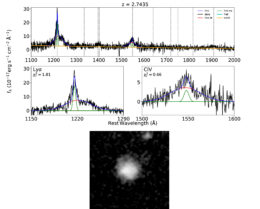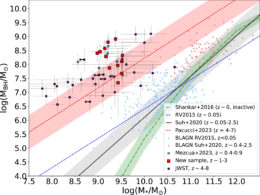For the first time, researchers have examined unexpectedly massive black holes during a time period called cosmic noon. These black holes may fill in the gap between over-massive black holes in the early universe and those present today.
Black Holes Then and Now

Illustration of the formation of a massive black hole seed from the collapse of a gas cloud in the early universe. Click to enlarge. [NASA/STScI/Leah Hustak]
Observations of black holes in the universe today support the hypothesis that many supermassive black holes grew from massive seeds, and low-mass galaxies with over-massive black holes are common in the local universe as well as in the early universe. But what’s missing from this tale of black hole growth is what happened in between these two time periods: where’s the link between over-massive black holes in the early universe and today?

Observations of a low-mass galaxy with an active galactic nucleus. Click to enlarge. [Adapted from Mezcua et al. 2024]
Activity at Cosmic Noon
To connect these two epochs, Mar Mezcua (Institute of Space Sciences, Spain) and collaborators looked toward a period of the universe’s history known as cosmic noon. This period, when the universe was just 2–3 billion years old, is marked by high star-formation rates and fast black hole growth. To study black holes during this time period, Mezcua’s team searched for galaxies containing actively accreting supermassive black holes, also called active galactic nuclei.
Starting from a sample of more than a thousand galaxies with active galactic nuclei, the team selected 12 low-mass galaxies with high-quality data and redshifts that placed them at cosmic noon. Measurements of emission-line widths revealed that these black holes were roughly 100–1,000 times more massive than the black holes in similarly sized active galaxies in the local universe. They are also more massive than expected given the typical ratio of black hole mass to stellar mass.
Drawn from the Same Population

Black hole mass versus galaxy stellar mass for the black holes in this study (red squares), over-massive black holes in the early universe (dark purple squares), and other populations of black holes. Click to enlarge. [Mezcua et al. 2024]
The two groups of black holes may have different reasons for being overly massive, though: in the early universe, the presence of too-massive black holes is thought to mean that these black holes grew from massive “seed” black holes. Later, at cosmic noon, black hole feedback has had time to disrupt and heat star-forming gas, and interactions between galaxies have stripped away star-forming material. Both of these processes could cause a black hole to remain large compared to its host galaxy.
This marks the first time researchers have studied over-massive black holes during cosmic noon, and there’s much more to learn about black holes in this time period. An investigation into outflows and mergers may help researchers understand how these outsize black holes formed and grew.
Citation
“Overmassive Black Holes at Cosmic Noon: Linking the Local and the High-Redshift Universe,” Mar Mezcua et al 2024 ApJL 966 L30. doi:10.3847/2041-8213/ad3c2a

